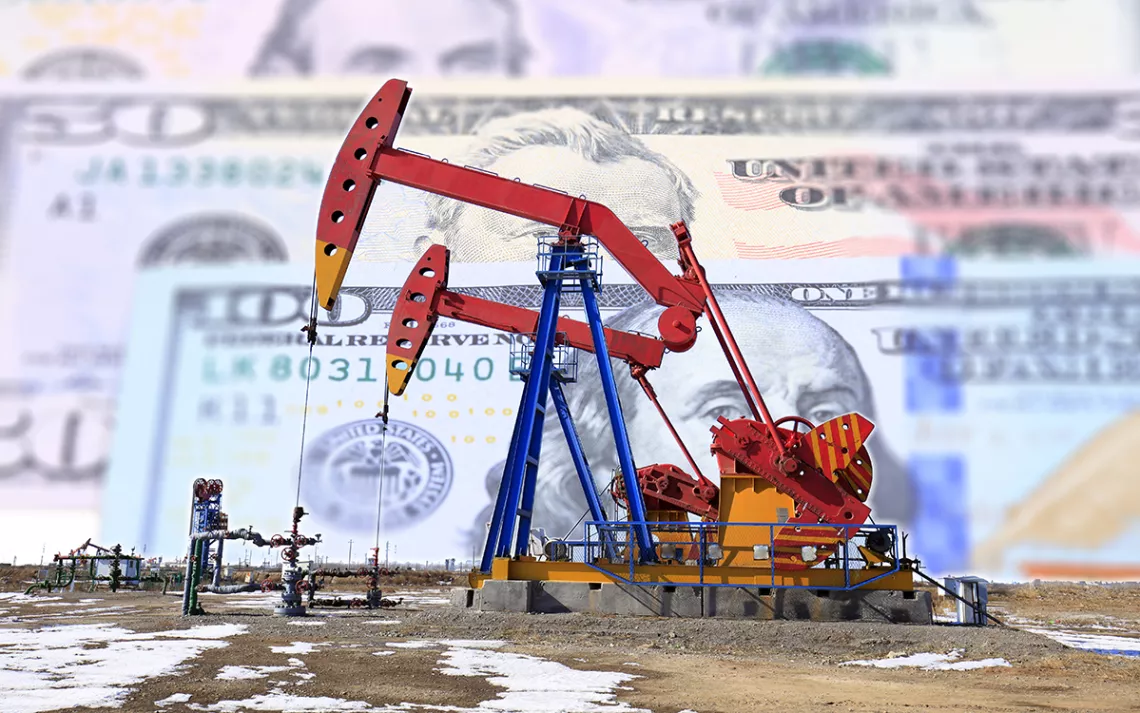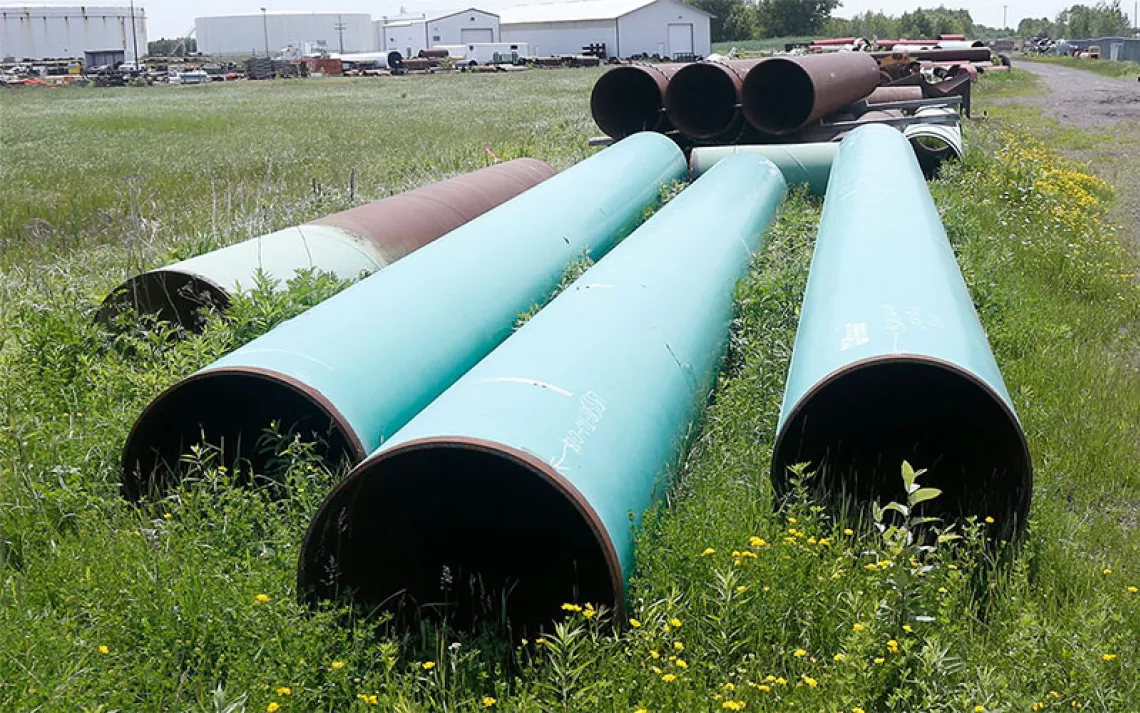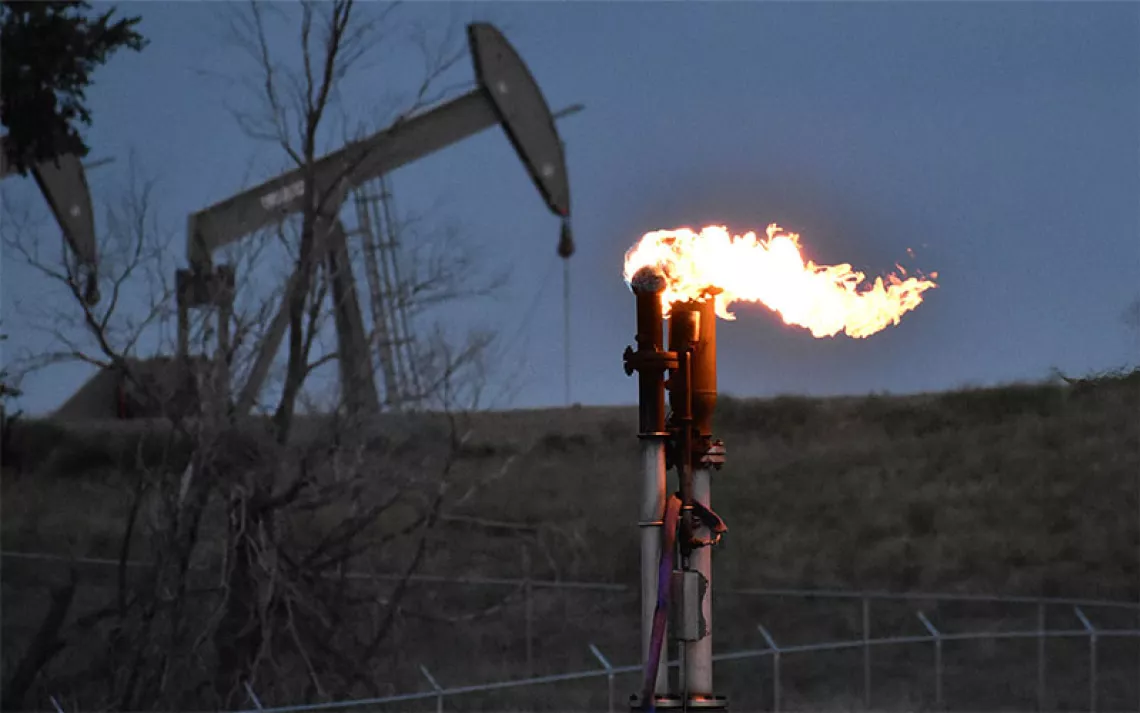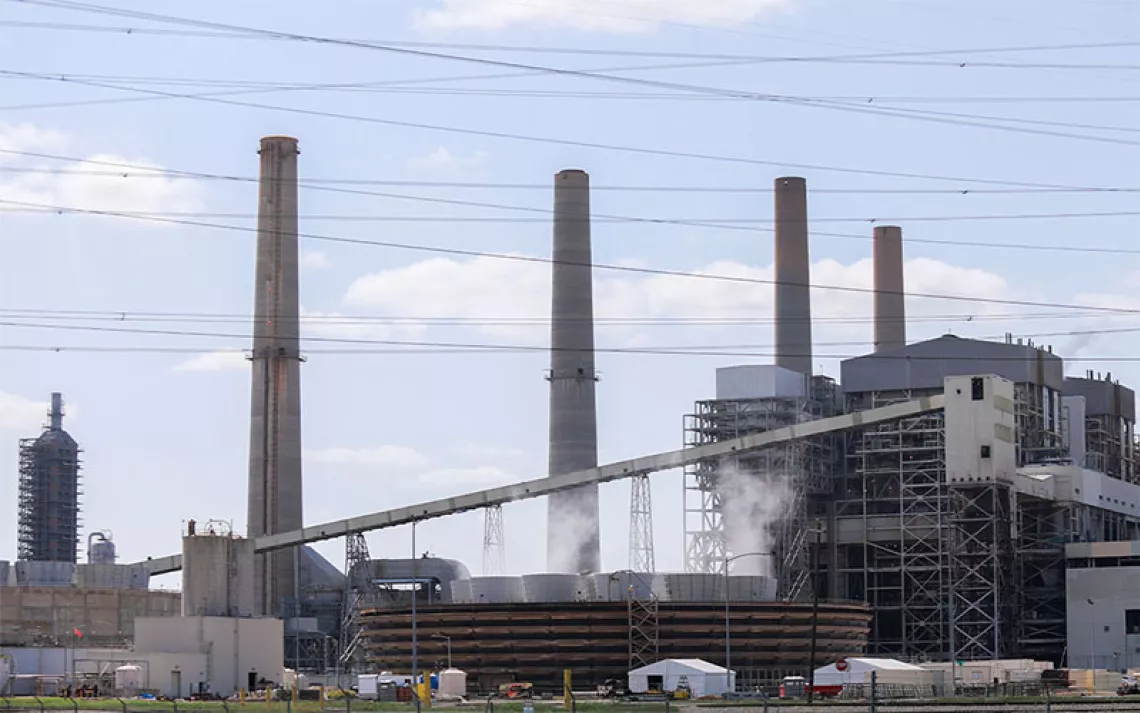Bailout: Billions of Dollars of Federal COVID-19 Relief Money Flow to the Oil Industry
The Trump administration is spending pandemic money for oil bailouts

Photo by zhengzaishuru/iStock
Patricia Nelson’s Greeley, Colorado, neighborhood is overrun with fracking operations. Greeley is the county seat of Weld County, home to nearly 90 percent of all oil produced in the state. Nelson is the daughter of Mexican immigrants, and four generations of her family have helped establish a thriving Latinx community here along Colorado’s Front Range. Nelson is one of the most well-known and outspoken opponents of fracking in Colorado. Now, she and her neighbors face another struggle for survival—against COVID-19.
The coronavirus has ravaged this disproportionately low-income community of color. Two of Nelson’s sisters and two of her aunts—one of whom is currently in the ICU—and her aunt’s husband have all contracted the disease. They have survived, but several friends have not. Due to the pandemic, Nelson’s husband, Nick, lost his job. Nelson left her job for health reasons before the virus struck and as a result, did not qualify for federal unemployment assistance. To support her seven-year-old son, Diego, she has been forced to spend virtually her entire 401K retirement account.
Now the Trump administration is spending billions of dollars in COVID-19 relief money to bail out the oil industry. Many of the oil companies in Nelson’s neighborhood—as well as virtually every one of the largest operators in Colorado—are reaping tens of millions of dollars in pandemic recovery benefits, among the billions of dollars obtained by the industry nationwide.
Nelson is frustrated. But, given that “the Trump administration’s constituents are the corporations, not the people,” she argues, “I’m not surprised this is happening.”
Plans for oil-industry-specific bailouts were effectively shut down by congressional Democrats. But, with help from congressional Republicans, billions of taxpayer dollars are flowing to the industry. The money is providing a clear lifeline to companies that were long-distressed prior to the pandemic. It is hard to see lasting benefits for workers, however, as many of these same companies slash jobs and benefits. And it is likely too little too late for an oil industry that appears beyond resuscitation, even by Trump (see The End of Oil Is Near).
Three primary tranches of federal COVID-19 relief money are currently sending billions of dollars to the oil and gas industry: the Paycheck Protection Program (PPP) of the Coronavirus Aid, Relief, and Economic Security Act (CARES Act), a tax loophole in the CARES Act, and several new Federal Reserve programs, including one that has made the American taxpayer a direct holder of tens of millions of dollars in oil company debt.
Economist Belinda Archibong, assistant professor at Barnard College of Columbia University, argues that this approach is backwards. “The oil industry has been shedding jobs for years. There is no evidence that if you roll back regulations, invest more in fossil fuel companies, that it will result in more jobs,” she explains. There’s a “whole new line of employment if we invest in clean renewable green business and this will result in more jobs. This is where the focus needs to be, where we should direct federal funding,” she argues.
Patricia Nelson | Photo by Antonia Juhasz
The Paycheck Protection Program: $3 Billion to $7 Billion Paid to Over 7,000 Oil and Gas Companies
Launched on March 27, the Paycheck Protection Program (PPP) of the CARES Act is administrated by the US Small Business Administration and provides forgivable loans to companies that retain and pay workers.
An estimated 7,075 oil, gas, and petrochemical companies received PPP funds totaling between approximately $3 billion to $7 billion, according to an analysis of the SBA data by Documented for Sierra. Over 10 percent of these companies reported no jobs retained as a result of the loan. Documented, a watchdog research organization that investigates corporations, identified the companies using North American Industry Classification System codes included in the loan data released by the US Small Business Administration.
Providing billions of dollars to oil and gas companies contributed to the PPP’s overall bias toward white-male-owned businesses. For those oil and gas companies that identified the owners’ races and genders, Documented found that these loans went overwhelmingly to white men (85 percent white, 86 percent male). This is not surprising given that virtually all US oil and gas companies are run by white men, who also compose the majority of its US workforce.
Though the funds are intended for small businesses, companies worth as much as $15 million with as many as 1,500 employees are eligible for loans of as much as $10 million. The Trump administration refused to release details of loan recipients until July 6, and the data remains incomplete. Loan amounts are given in ranges (such as $5 million to $10 million) and company names are provided for fewer than 15 percent of the nearly 5 million loans issued (though job sector, state, and other information is provided for all loan recipients).
In Colorado, Documented identified almost 750 oil and gas companies that received PPP loans. The firms were prominent among those that sought the largest loans in the state.
Many more oil and gas companies could become eligible for PPP loans if Senate Republicans succeed in changing the eligibility to include companies that have filed for bankruptcy. Staggeringly high rates of bankruptcy have plagued the oil and gas industry for years and then in the second quarter of 2020, they skyrocketed again, reaching a record four-year high.
Patricia Nelson wants these dollars to go toward building a green economy. “They should be subsidizing solar panels for peoples’ homes and start training programs for people to work in these green jobs,” she argues. Yet, Accountable.US found that only between $85 and $188 million in PPP loans went to just 239 renewable wind and solar companies nationwide. The renewable energy sector has been hit hard by the crisis, shedding some 600,000 jobs by April—with job losses disproportionately hitting Hispanic workers, while the PPP loans only helped retain 8,112 jobs.
CARES Act Tax Loophole: $3.2 Billion to at Least 50 Publicly Traded Companies
A tax loophole snuck into the CARES Act has allowed dozens of oil companies and contractors—including very large corporations—to receive billions of dollars in combined write-offs. Unlike the PPP, the tax provision includes no requirements on companies that take advantage of it, such as retaining workers, and many of these companies later shed jobs (detailed below). In a newly proposed stimulus bill, House Democrats included several mechanisms to scale back this tax loophole.
Jesse Coleman, senior researcher at Documented, dug through the US Securities and Exchange Commission filings of publicly traded companies, identifying for Sierra more than 50 oil and gas companies that took the tax benefit. The provision loosened rules governing how businesses deduct net operating losses. The write-off is equally available to the privately held companies that abound in the oil and gas sector, but there is no requirement that they make their taxes publicly available.
Marathon Petroleum Corporation took a whopping $1.1 billion tax write-off using the measure. Marathon Oil (previously the parent company of Marathon Petroleum) received an $89 million write-off. Occidental, one of Colorado’s largest oil and gas producers, took $195 million in tax write-offs. Denver-based Liberty Oilfield Services received a $9.3 million tax refund. Other large companies that took advantage of the loophole include Valero ($117 million), Devon ($98 million), and Superior ($30 million).
Federal Reserve Corporate Debt Market Financing Via BlackRock: Billions to Fossil Fuel Companies
At the end of 2019, US energy companies accounted for more than 90 percent of all defaults on corporate debt. Today, you and I are backing their play. With the Federal Reserve, the American taxpayer is now a direct holder of over $315 million in fossil fuel company debt, which is unprecedented. We hold debt in the leading oil, pipeline, petrochemical, and service companies, including ExxonMobil, Chevron, BP, Energy Transfer, Marathon, Phillips 66, Noble Energy, Kinder Morgan, Schlumberger, Baker Hughes, and many more, according to Federal Reserve disclosures.
“I wonder if the American public knows that it is now with the Fed a holder of all of this fossil fuel debt, and how that makes the public feel?” asked Alexis Goldstein, a senior policy Analyst at Americans for Financial Reform.
The purchases are a result of the biggest pot of COVID-19 federal relief monies benefiting the fossil fuel industry. It derives from $75 billion in taxpayer funds used to seed $750 billion that BlackRock is steering into the corporate debt market on behalf of the Federal Reserve via two newly established mechanisms: the Primary and Secondary Market Corporate Credit Facilities (PMCCF and SMCCF). The facilities benefit the oil and gas industry through the direct purchase of their debt and by the signal sent to other investors that these are purchases worth making.
Immediately after the programs were announced in March, ExxonMobil borrowed $9.5 billion in the US corporate bond market. By late May, two BlackRock investment funds that include energy stocks had surged in growth, one nearly doubling to over $46 billion. The debt purchases include oil and gas companies that are rated as “junk bonds.”
“That’s the market confidence,” explains Goldstein, who began her career on Wall Street. When the Federal Reserve purchases oil company debt, “it sends a signal of confidence to the markets, and one way they may interpret this is that the Fed thinks these firms are strong and that the sector has a future and that’s going to impact the decisions of other investors.”
She describes the Fed programs as a “money bazooka,” which raises important concerns, including that the Federal Reserve has “a responsibility to manage any systemic risk, and climate change is a systemic risk.”
The Federal Reserve established its own index of bonds to purchase. By August 10, nearly 9.5 percent of this list were fossil fuel companies, the Fed’s disclosures reveal. An analysis by the research organization InfluenceMap compared this index with others, such as the S&P 1500, and found that the Federal Reserve bond purchases heavily overweighed fossil fuels. These raise many red flags because the Federal Reserve is prohibited from exercising bias on behalf of a particular sector or firm.
“Does the open lobbying by Trump and the energy secretary, who’ve made it clear they want to pull out all the stops for America’s oil and gas firms, have anything to do with the Fed being overweight in fossil fuels?” asks Goldstein. A letter from some 70 leading environmental organizations decrying the purchases raises the same concern while also stating that the Federal Reserve Board is “intensifying risks to financial stability by supporting the fossil fuel sector.”
BlackRock is the world’s largest asset manager and has been a target of campaigners for the nearly $90 billion in its fossil fuel portfolio in 2019 alone. Earlier this year, a global network of advocacy groups called “BlackRock’s Big Problem” celebrated, and took some credit for, BlackRock’s announcement to fundamentally reshape its operations to address climate change, including largely divesting from coal. But they say its portfolios still contain oil and natural gas and other large agribusiness drivers of deforestation.
The Federal Reserve also launched a new Main Street Lending Program targeting midsize firms. The Trump administration sought and received a host of modifications to the program specifically meeting the needs (and lobbying efforts) of struggling oil companies. Among them, the elimination of a requirement that borrowers attest that they need the financing due to the pandemic. The program, expected to dole out up to $600 billion, could be a significant savior for many oil companies that would otherwise have (rightly) collapsed under the weight of their debt. Facing sharp public scrutiny, it has been slow to get off the ground, and as of August 10, Federal Reserve disclosures cite just 13 loans issued including to one energy company, Gulf South Energy Services of Louisiana.
Gregg Gelzinis, a senior policy analyst for Economic Policy at American Progress, warns the public not to take its eyes off of this program. The oil and gas industry continues to lobby for more favorable changes to its loan terms, he explains, and as the economy worsens, the loans are likely to look more enticing.
Take the Bailout, Boost Executive Salaries, Slash Workers
Companies that have reaped the billions of dollars in these benefits are also among those simultaneously rewarding executives and slashing workers and benefits.
Over 10 percent of the more than 7,000 oil, gas, and petrochemical companies that received PPP funds totaling between $3 billion and $6 billion reported no jobs retained as a result of the loan.
The CEOs of Exxon and Chevron got raises in 2020, while Exxon announced that it is suspending the company’s contribution to the US employee retirement savings plan beginning in October and Chevron is cutting 6,700 workers around the globe. Marathon Oil is laying off 200. Marathon Petroleum is permanently shuttering two US oil refineries, one in California and another in New Mexico, with a combined nearly 1,000 employees. BP is cutting 10,000 workers worldwide, Schlumberger is cutting 21,000, and Baker Hughes has laid off hundreds of workers.
In Colorado, Occidental and Noble Energy reduced the hours and pay of hundreds of workers across Colorado. In August, Occidental reversed the decision to cap its executives’ salaries. Denver-based Liberty Oil Field Services fired 342 employees in the state.
“They’re getting all this money, but we’re still having all these oil and gas companies in Colorado lay off their workers anyway—that’s infuriating!” said Patricia Nelson, who has family members who work in the industry. “They’re not investing in their workers. They’re investing in themselves.” She wants the nation to get off of the fossil fuel roller coaster, which exposes local communities like hers and the nation as a whole to an industry that she describes as “unpredictable,” “volatile,” and “unsafe.”
Economist Belinda Archibong agrees. To fully recover from this crisis, she argues that COVID-19 federal funding must first help people combat the virus, particularly those in the hardest-hit Black, Hispanic, and other minority communities, and then rebuild with a green economy. She sees the two efforts as intimately intertwined. Economists call it a “double dividend,” she explains. “Less pollution means healthier people and healthier workers,” which is better for people, companies, and the entire economy.
 The Magazine of The Sierra Club
The Magazine of The Sierra Club







